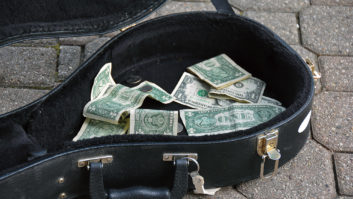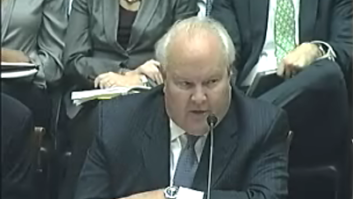Webcasting royalty fees in play
Feb 1, 2006 12:00 PM, By Harry Martin
A new proceeding has begun to set the music copyright royalty fees that stations streaming on the Internet will pay to record companies and recording artists for 2006-2010. The new fees are not likely to be finalized until late in 2006, but, once set, they will apply retroactively to Jan. 1, 2006.
A total of 41 parties have signed up to participate in the rate proceeding. These include radio broadcast associations, including NPR and the NRB; more than 10 large radio group owners; large Internet-only webcasters not affiliated with on-air radio stations; satellite radio companies; Internet media companies such as Yahoo and AOL; webcasting service companies, which provide a variety of services for large numbers of on-air and Internet-only webcasters; and the two principal combatants: Digital Media Association (DIMA), the trade association for large Internet-only webcasters and big Internet media companies; and Sound Exchange, which represents, collects copyright royalty fees for, and distributes the fees to 1,000 record companies and 12,000 recording artists holding copyrights for 85 percent of the music recordings sold in the United States.
A new start
A three-month negotiation period ended in May 2005 without a settlement between record labels and webcasters. That set the stage for the submission of written fee proposals to the Copyright Royalty Judges (CRJ) in October.
DIMA proposed much lower royalty fees than those currently paid. It proposed that webcasters pay 5.5 percent of revenues, which it said was essentially equal to the royalties webcasters pay to music publishers and songwriters through ASCAP, BMI and SESAC. Currently, only small webcasters pay fees based on a percentage of their revenues. As alternatives, DIMA proposed that webcasters continue to be subject to the current rate structure, which provides for a fixed price per hour of music streamed or a fixed price per song streamed. DIMA proposed a per-hour/per-listener fee of 0.38 cents (compared with the current per-hour fee of 1.17 cents) and a per-song/per-listener fee of 0.025 cents (compared to the current per-song fee of 0.076 cents). Large and small webcasters would pay the same fees.
Sound Exchange countered with a proposal for a large increase in royalty fees. It proposed that webcasters pay the larger of: (1) 30 percent of revenue; (2) 0.0019 cents per-song/per-listener; or (3) a per-hour/per-listener fee of 0.0247 cents for broadcast music simulcasts, 0.0019 cents for non-music broadcast simulcasts, and 0.02945 cents for Internet-only webcasts. An adjustment factor of 25 percent would be added for all webcasts not proven to have been transmitted without any wireless component. For webcasters generating revenues, this would work out to paying Sound Exchange a total of 37.5 percent of revenues.
The on-air broadcasters proposed a flat annual fee, regardless of the number of listeners, for streaming. The fee would be based on the on-air station’s market position and BIA revenue rank. In the five largest markets, stations would pay $8,000 annually, mid-size stations $6,500 and small stations $6,000. Fees for stations in smaller markets would be lower, with rates for markets 101 to 200 ranging from $500 to $1,000. Stations webcasting at least 95 percent news, business, talk or sports would pay a lower flat annual fee, ranging from $750 in the top-10 markets to $250 in the smallest markets. Stations webcasting at least 25 percent news, business, talk or sports would be subject to a different fee structure. The minimum fee for partial-year streaming would be $250. All fees would increase 4 percent per year.
If no settlement is reached within a few months, the CRJs will issue a decision.
Dateline
April 1 is the deadline for radio stations, LPFMs and FM translator stations in Delaware and Pennsylvania to file their 2006 renewal applications.
Also by April 1, radio stations (but not LPFMs or FM translators) in Delaware and Pennsylvania must file with the FCC their biennial ownership reports and annual EEO program reports, and place their annual EEO reports in their public files and post them on their websites.
April 1 is the filling date for biennial ownership reports for radio stations in Indiana, Kentucky and Tennessee.
Stations in Texas also must place their annual EEO reports in their pubic files and on their websites by April 1.
Martin is immediate-past president of the Federal Communications Bar Association and a member of Fletcher, Heald & Hildreth, Arlington, VA. E-mail[email protected].









